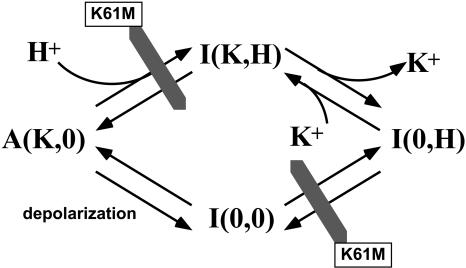FIGURE 12.
Four-state model for the interaction between external K and internal pH. This model is consistent with the slow inactivation of ROMK (Kir1.1) by depolarization. The inactivated I(K,H) state is reached from the active A(K,0) state by protonation of the pH sensor (Kir1.1b-K61). The mutation K61M blocks this pathway as well as the transition between I(0,0) and I(0,H). The further removal of external K drives the system from the pH-closed state, I(K,H), to the inactivated I(0,H) state. Elevation of external K shifts the equilibrium from I(0,H) to I(K,H). A fourth state, I(0,0), can be reached by depolarization without protonation.

